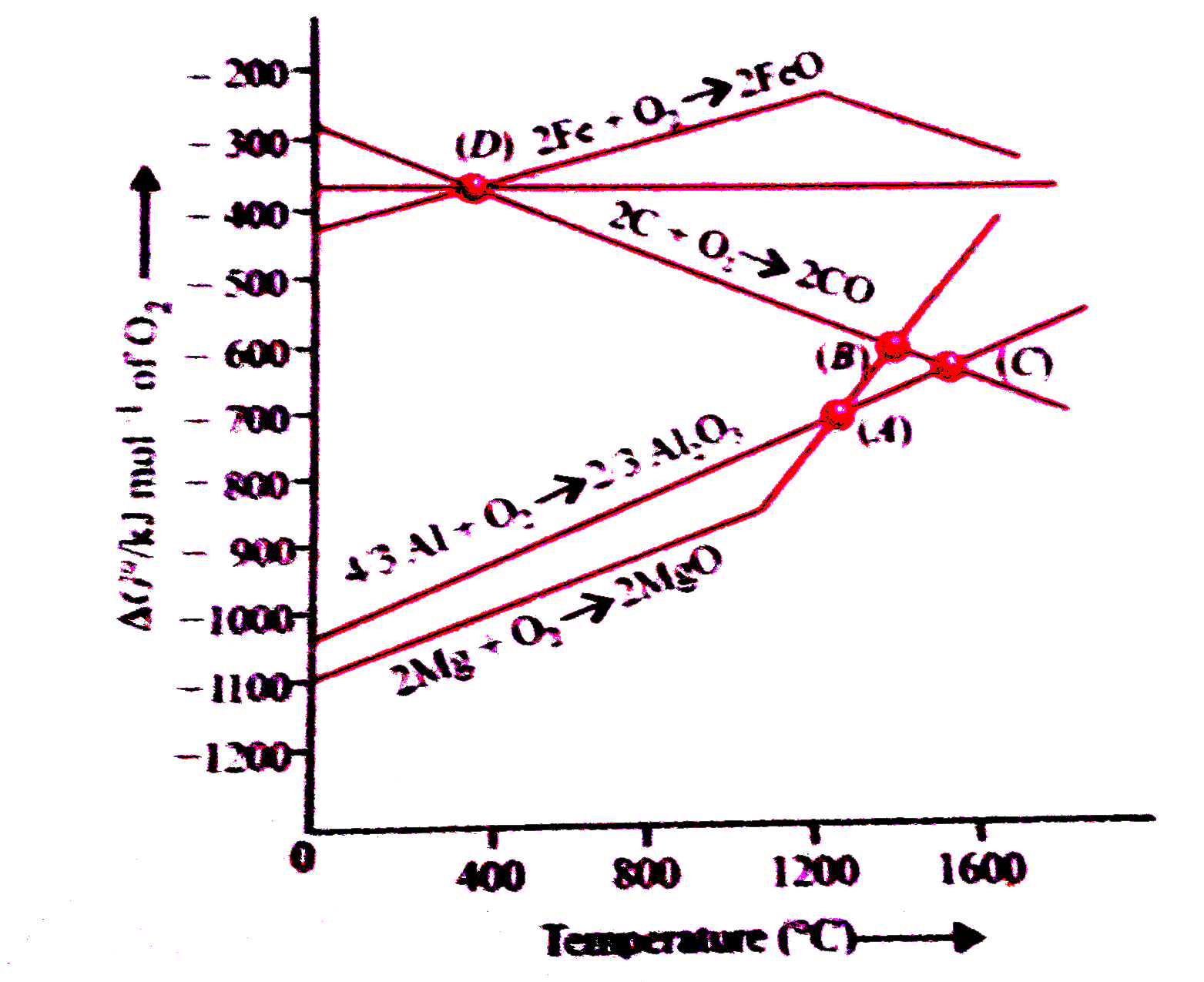Coke can be used to reduce . Explain it based on thermodynamic view.
To explain how coke (carbon) can be used to reduce cuprous oxide (Cu₂O) based on a thermodynamic view, we can break down the process into several steps:
Step 1: Understanding the Reduction Reaction
The reduction of cuprous oxide (Cu₂O) to copper (Cu) can be represented by the following reaction:
Cu2O+e−→2Cu+O2−
Step 2: Analyzing the Gibbs Free Energy Change
The Gibbs free energy change (ΔG) for the reduction of Cu₂O is positive, indicating that this reaction is non-spontaneous under standard conditions. A positive ΔG means that the reaction does not occur naturally without the input of energy.
Step 3: Reaction of Coke with Oxygen
When coke (carbon) reacts with oxygen, it forms carbon monoxide (CO) according to the reaction:
C+12O2→CO
This reaction has a highly negative ΔG value, which means it is spontaneous and can occur without external energy input.
Step 4: Coupling the Reactions
To make the reduction of Cu₂O spontaneous, we can couple the two reactions. By combining the non-spontaneous reduction of Cu₂O with the spontaneous reaction of carbon, we create a scenario where the overall process can proceed.
Step 5: Overall Gibbs Free Energy Change
When we combine the two reactions, the negative ΔG from the carbon oxidation can offset the positive ΔG from the reduction of Cu₂O. The overall ΔG for the combined reactions becomes negative, making the entire process spontaneous:
ΔGoverall=ΔGCu2O+ΔGC<0
Conclusion
Thus, by using coke (carbon) to reduce cuprous oxide (Cu₂O), we can make the overall reaction thermodynamically favorable. The spontaneous reaction of carbon with oxygen provides the necessary energy to drive the reduction of Cu₂O to copper.
---
The reduction of cuprous oxide (Cu₂O) to copper (Cu) can be represented by the following reaction:
Cu2O+e−→2Cu+O2−
The Gibbs free energy change (ΔG) for the reduction of Cu₂O is positive, indicating that this reaction is non-spontaneous under standard conditions. A positive ΔG means that the reaction does not occur naturally without the input of energy.
When coke (carbon) reacts with oxygen, it forms carbon monoxide (CO) according to the reaction:
C+12O2→CO
This reaction has a highly negative ΔG value, which means it is spontaneous and can occur without external energy input.
To make the reduction of Cu₂O spontaneous, we can couple the two reactions. By combining the non-spontaneous reduction of Cu₂O with the spontaneous reaction of carbon, we create a scenario where the overall process can proceed.
When we combine the two reactions, the negative ΔG from the carbon oxidation can offset the positive ΔG from the reduction of Cu₂O. The overall ΔG for the combined reactions becomes negative, making the entire process spontaneous:
ΔGoverall=ΔGCu2O+ΔGC<0
Thus, by using coke (carbon) to reduce cuprous oxide (Cu₂O), we can make the overall reaction thermodynamically favorable. The spontaneous reaction of carbon with oxygen provides the necessary energy to drive the reduction of Cu₂O to copper.
Topper's Solved these Questions
- GENERAL PRINCIPLES AND PROCESSES OF ISOLATION OF ELEMENTSBook:AAKASH INSTITUTE ENGLISHChapter:GENERAL PRINCIPLES AND PROCESSES OF ISOLATION OF ELEMENTSExercise:Aakash Challengers Questions
Explore 8 Videos
- GENERAL PRINCIPLES AND PROCESSES OF ISOLATION OF ELEMENTSBook:AAKASH INSTITUTE ENGLISHChapter:GENERAL PRINCIPLES AND PROCESSES OF ISOLATION OF ELEMENTSExercise:Assignment (Section-D) Assertion-Reason Type Question
Explore 15 Videos
- HALOALKANES AND HALOARENES Book:AAKASH INSTITUTE ENGLISHChapter:HALOALKANES AND HALOARENES Exercise:ASSIGNMENT SECTION -D
Explore 15 Videos
Similar Questions
Knowledge Check
Ammonia is used in detection of Cu2+ ion because
A1. aqueous solution of NH3 reacts with Cu2+ ion to form deep blue coloured complexB2. NH3 reacts with Cu2+ ion to give blue precipitate of CuOC3. aqueous solution of NH3 reacts with Cu2+ ion to form white coloured complexD4. NH3 reacts with Cu2+ ion to give green precipitate.
Coke does not cause reduction of Al2O3. Explain ΔG∘ (in kJ mol−1) for Al2O3 : -1582, CO = - 137.2.
View SolutionHow many statement are false ?
(i) Thermodynamics is concerned with total energy of the system.
(ii) 1st law of thermodynamics can be applied on the individual particle enclosed in vessel.
(iii) Many thermodynamic properties can not be measured absolutely, so change in thermodynamics property is required for calculation.
(iv) Feasibility of any chemical reaction can not be explained by thermodynamics.
(v) When surrounding is always in equilibrium with the system, the process called reversible.
(vi) Thermodynamics predict the time of attain the equilibrium
View SolutionHow does Cu2O act as both oxidant and reductant ?
View SolutionH2O2 is reduced by
View Solution
At the points of intersection of Al2O3 and MgO curves (A), ΔG∘ becomes zero for reaction,
23Al2O3+2Mg→2MgO+43Al
Above this point, magnesium can reduce alumina. Although thermodynamically feasible, Mg is not used to reduction of Al2O3 because
View SolutionWhich metal is used for reducing Cr2O3 and Mo2O3 to metal ?
View SolutionWhich metal is used for reducing Cr2O3 and Mo2O3 to metal ?
View Solution

